Influence of ZrB2 on Microstructure and Properties of Steel Matrix Composites Prepared by Spark Plasma Sintering
Abstract
:1. Introduction
2. Materials and Experimental Methods
- 316L steel + 5 wt.% ZrB2
- 316L steel + 10 wt.% ZrB2
- 316L steel + 15 wt.% ZrB2
- 316L steel + 20 wt.% ZrB2.
- Ff is the measured friction force,
- Fn is the applied normal force,
- L—sliding distance [m].
- WV(disc)—specific wear rate of disc [mm3/Nm];
- Vdisc—wear volume of disc specimen [mm3];
- Fn—applied load [N];
- L—sliding distance [m].
- R—radius of wear track [mm],
- S1 to S4—cross-sectional areas at four places on the wear track circle [mm2].
3. Results
4. Conclusions
Author Contributions
Funding
Conflicts of Interest
References
- Kang, S.-J.L. Sintering, Densification, Grain Growth, and Microstructure, 1st ed.; Butterworth-Heinemann: Oxford, UK, 2005. [Google Scholar]
- Geraman, R.M. Sintering Theory and Practice; Wiley-Interscience, MPIF: Hoboken, NJ, USA, 1996. [Google Scholar]
- Stuijts, A.L. Synthesis of Materials from Powders by Sintering. Annu. Rev. Mater. Res. 1973, 3, 363–395. [Google Scholar] [CrossRef]
- Shamsuddin, S.; Jamaludin, S.B.; Hussain, Z.; Ahmad, Z. The Effects of Al2O3 Amount on the Microstructure and Properties of Fe-Cr Matrix Composites. Met. Mater. Trans. A 2010, 41, 3452–3457. [Google Scholar] [CrossRef]
- Abenojar, J.; Velasco, F.; Bautista, M.A.; Campos, M.; Bas, J.; Torralba, J.M. Atmosphere influence in sintering process of stainless steels matrix composites reinforced with hard particles. Compos. Sci. Technol. 2003, 63, 69–79. [Google Scholar] [CrossRef]
- Feizabadi, J.; Khaki, J.V.; Sabzevar, M.H.; Sharifitabar, M.; Sani, S.A. Fabrication of in situ Al2O3 reinforced nanostructure 304 stainless steel matrix composite by self-propagating high temperature synthesis process. Mater. Des. 2015, 84, 325–330. [Google Scholar] [CrossRef]
- Wang, Y.; Zhang, Z.; Wang, H.; Ma, B.; Jiang, Q. Effect of Fe content in Fe–Ti–B system on fabricating TiB2 particulate locally reinforced steel matrix composites. Mater. Sci. Eng. A 2006, 422, 339–345. [Google Scholar] [CrossRef]
- Nahme, H.; Lach, E.; Tarrant, A. Mechanical property under high dynamic loading and microstructure evaluation of a TiB2 particle-reinforced stainless steel. J. Mater. Sci. 2009, 44, 463–468. [Google Scholar] [CrossRef]
- Tjong, S.C. Abrasion resistance of stainless-steel composites reinforced with hard TiB2 particles. Compos. Sci. Technol. 2000, 60, 1141–1146. [Google Scholar] [CrossRef]
- Fedrizzi, A.; Pellizzari, M.; Zadra, M.; Marin, E. Microstructural study and densification analysis of hot work tool steel matrix composites reinforced with TiB2 particles. Mater. Charact. 2013, 86, 69–79. [Google Scholar] [CrossRef]
- Tokita, M. Trends in Advanced SPS Spark Plasma Sintering Systems and Technology. Functionally Gradient Materials and Unique Synthetic Processing Methods from Next Generation of Powder Technology. J. Soc. Powder Technol. Jpn. 1993, 30, 790–804. [Google Scholar] [CrossRef] [Green Version]
- Munir, Z.A.; Anselmi-Tamburini, U.; Ohyanagi, M. The effect of electric field and pressure on the synthesis and consolidation of materials: A review of the spark plasma sintering method. J. Mater. Sci. 2006, 41, 763–777. [Google Scholar] [CrossRef]
- Omori, M. Sintering, consolidation, reaction and crystal growth by the spark plasma system (SPS). Mater. Sci. Eng. A 2000, 287, 183–188. [Google Scholar] [CrossRef]
- Yamazaki, K.; Risbud, S.; Aoyama, H.; Shoda, K. PAS (Plasma activated sintering): Transient sintering process control for rapid consolidation of powders. J. Mater. Process. Technol. 1996, 56, 955–965. [Google Scholar] [CrossRef]
- Tokita, M. Industrial applications for functionally graded materials fabricated by spark plasma sintering (SPS) systems. In Proceedings of the 4th Korea-Russia International Symposium On Science and Technology, Ulsan, Korea, 27 June–1 July 2000; pp. 251–256. [Google Scholar]
- Peckner, D.; Bernstein, J.M. Handbook of Stainless Steels; Davis, J.R., Ed.; Mc Graw, Hill Book Co.: Bernstein, Austria, 1977. [Google Scholar]
- Akhtar, F.; Shiju, G. On the processing, microstructure, mechanical and wear properties of cermet/stainless steel layer composites. Acta Mater. 2007, 55, 1467–1477. [Google Scholar]
- Tavares, S.S.M.; Moura, V.; Costa, V.C.; Ferreira, M.L.R.; Pardal, J.M. Microstructural changes and corrosion resistance of AISI 310S steel exposed to 600–800 °C. Mater. Charact. 2009, 60, 573–578. [Google Scholar] [CrossRef]
- Lin, S.; Weihao, X. Microstructure and abrasive behaviors of TiC-316L composites prepared by warm compaction and microwave sintering. Adv. Powder Technol. 2012, 23, 419–425. [Google Scholar] [CrossRef]
- Clyne, T.W.; Withers, P.J. (Eds.) An Introduction to Metal Matrix Composites; Cambridge University Press: Cambridge, UK, 1995. [Google Scholar]
- Baghani, M.; Aliofkhazraei, M.; Poursalehia, R. Microwave-assisted Sintering of Fe-Al2O3 Nanocomposites: Study of Corrosion and Wear Properties. Procedia Mater. Sci. 2015, 11, 689–694. [Google Scholar] [CrossRef] [Green Version]
- Vardavoulias, M.; Jeandin, M.; Velasco, F.; Torralba, J.M. Dry sliding wear mechanism for P/M austenitic stainless steels and their composites containing Al2O3 and Y2O3 particles. Tribol. Int. 1996, 29, 499–506. [Google Scholar] [CrossRef]
- Obadele, B.; Lepule, M.L.; Andrews, A.; Olubambi, P. Tribocorrosion characteristics of laser deposited Ti–Ni–ZrO2 composite coatings on AISI 316 stainless steel. Tribol. Int. 2014, 78, 160–167. [Google Scholar] [CrossRef]
- Patankar, S.; Tan, M.J. Role of reinforcement in sintering of SiC/316L stainless steel composite. Powder Met. 2000, 43, 350–352. [Google Scholar] [CrossRef]
- Marques, B.; Fernandes, C.M.S.; Senos, A.M.R. Sintering, microstructure and properties of WC-AISI304 powder composites. J. Alloys Compd. 2013, 562, 164–170. [Google Scholar] [CrossRef]
- Akhtar, F.; Feng, P.; Du, X.; Jawid, A.S.; Tian, J.; Guo, S. Microstructure and property evolution during the sintering of stainless steel alloy with Si3N4. Mater. Sci. Eng. A 2008, 472, 324–331. [Google Scholar] [CrossRef]
- Sulima, I.; Putyra, P.; Hyjek, P.; Tokarski, T. Effect of SPS parameters on densification and properties of steel matrix composites. Adv. Powder Technol. 2015, 26, 1152–1161. [Google Scholar] [CrossRef]
- Aparicio-Fernández, R.; Springer, H.; Szczepaniak, A.; Zhang, H.; Raabe, D. In-situ metal matrix composite steels: Effect of alloying and annealing on morphology, structure and mechanical properties of TiB2 particle containing high modulus steels. Acta Mater. 2016, 107, 38–48. [Google Scholar] [CrossRef]
- Sahoo, S.; Jha, B.B.; Sahoo, T.K.; Mandal, A. Influence of reinforcement and processing on steel-based composites: Microstructure and mechanical response. Mater. Manuf. Process. 2017, 33, 564–571. [Google Scholar] [CrossRef]
- Mukherjee, S.; Upadhyaya, G. Corrosion behaviour of sintered 434L ferritic stainless steel-Al2O3 composites containing phosphorus. Corros. Sci. 1985, 25, 463–470. [Google Scholar] [CrossRef]
- Rokanopoulou, A.; Skarvelis, P.; Papadimitriou, G. Improvement of the tribological properties of Al2O3 reinforced duplex stainless steel MMC coating by the addition of TiS2 powder. Surf. Coat. Technol. 2016, 289, 144–149. [Google Scholar] [CrossRef]
- Moghaddam, E.; Karimzadeh, N.; Varahram, N.; Davami, P. Impact–abrasion wear characteristics of in-situ VC-reinforced austenitic steel matrix composite. Mater. Sci. Eng. A 2013, 585, 422–429. [Google Scholar] [CrossRef]
- Fahrenholtz, W.G.; Hilmas, G.E.; Talmy, I.G.; Zaykoski, J.A. Refractory Diborides of Zirconium and Hafnium. J. Am. Ceram. Soc. 2007, 90, 1347–1364. [Google Scholar] [CrossRef]
- Venkateswaran, T.; Basu, B.; Raju, G.B.; Kim, D.Y.; Gupta, N. Densification and properties of transition metal borides-based cermets via spark plasma sintering. J. Eur. Ceram. Soc. 2006, 26, 2431–2440. [Google Scholar] [CrossRef]
- Chamberlain, A.L.; Fahrenholtz, W.G.; Hilmas, G.E.; Ellerby, D.T. High-Strength Zirconium Diboride-Based Ceramics. J. Am. Ceram. Soc. 2004, 87, 1170–1172. [Google Scholar] [CrossRef]
- Morz, C. Annual mineral review. Zirconium diboride. Am. Ceram. Soc. Bull. 1995, 74, 165–166. [Google Scholar]
- Sivakumar, S.; Brahma, R.G.; Koteswararao, V.R. Influence of ZrB2 hard ceramic reinforcement on mechanical and wear properties of aluminium. Ceram. Int. 2019, 45, 7055–7070. [Google Scholar] [CrossRef]
- Asadipanah, Z.; Rajabi, M. Production of Al–ZrB2 nano-composites by microwave sintering process. J. Mater. Sci. Mater. Electron. 2015, 26, 6148–6156. [Google Scholar] [CrossRef]
- Nallusamy, M.; Sundaram, S.; Kalaiselvan, K. Fabrication, characterization and analysis of improvements in mechanical properties of AA7075/ZrB2 in-situ composites. Measurement 2019, 136, 356–366. [Google Scholar] [CrossRef]
- Kumar, R.V.; Keshavamurthy, R.; Perugu, C.S.; Koppad, P.G.; Alipour, M. Influence of hot rolling on microstructure and mechanical behaviour of Al6061-ZrB2 in-situ metal matrix composites. Mater. Sci. Eng. A 2018, 738, 344–352. [Google Scholar] [CrossRef]
- Wang, C.; Lin, H.; Zhang, Z.; Li, W. Fabrication, interfacial characteristics and strengthening mechanisms of ZrB2 microparticles reinforced Cu composites prepared by hot-pressed sintering. J. Alloys Compd. 2018, 748, 546–552. [Google Scholar] [CrossRef]
- Kaku, S.M.Y.; Khanra, A.K.; Davidson, M.J. Effect of deformation on properties of Al/Al-alloy ZrB2 powder metallurgy composite. J. Alloys Compd. 2018, 747, 666–675. [Google Scholar] [CrossRef]
- Sulima, I.; Jaworska, L.; Wyżga, P.; Perek-Nowak, M. The influence of reinforcing particles on mechanical and tribological properties and microstructure of the steel-TiB2 composites. J. Achiev. Mater. Manuf. Eng. 2011, 48, 52–57. [Google Scholar]
- Sulima, I. Consolidation of AISI316L Austenitic Steel—TiB2 Composites by SPS and HP-HT Technology; Lakshmanan, A., Ed.; Sintering Techniques of Materials; IntechOpen: Rijeka, Croatia, 2015; pp. 125–153. [Google Scholar]
- Sulima, I.; Kowalik, R. Corrosion behaviors, mechanical properties and microstructure of the steel matrix composites fabricated by HP–HT method. Mater. Sci. Eng. A 2015, 639, 671–680. [Google Scholar] [CrossRef]
- Darabara, M.; Papadimitriou, G.D.; Bourithis, L. Tribological evaluation of Fe–B–TiB2 metal matrix composites. Surf. Coat. Technol. 2007, 202, 246–253. [Google Scholar] [CrossRef]
- Tjong, S.C.; Lau, K. Sliding wear of stainless steel matrix composite reinforced with TiB2 particles. Mater. Lett. 1999, 41, 153–158. [Google Scholar] [CrossRef]
- Taylor, R.P.; McClain, S.T.; Berry, J.T. Uncertainty analysis of metal-casting porosity measurements using Archimedes’ principle. Int. J. Cast Met. Res. 1999, 11, 247–257. [Google Scholar] [CrossRef]
- International Standard, Fine Ceramics (Advanced Ceramics, Advanced Technical Ceramics)-Determination of Friction and Wear Characteristics of Monolithic Ceramics by Ball-on-Disc Method, ISO 20808:2004(E). Available online: https://www.iso.org/standard/65415.html (accessed on 26 May 2020).
- Sulima, I.; Boczkal, S.; Jaworska, L. SEM and TEM characterization of microstructure of stainless steel composites reinforced with TiB2. Mater. Charact. 2016, 118, 560–569. [Google Scholar] [CrossRef]
- Molinari, A.; Straffelini, G.; Kazior, J.; Pieczonka, T. Microstructural optimization of boron alloyed austenitic stainless steel. Adv. Powder Metall. Part. Mater. 1996, 5, 17.3–17.12. [Google Scholar]
- Molinari, A.; Menapace, C.; Kazior, J.; Pieczonka, T. Liquid phase sintering of boron alloyed austenitic stainless steel. Mater. Sci. 2007, 534–536, 553–556. [Google Scholar]
- Wang, X.; Yao, X.; Zhang, H.; Liu, X.; Huang, Z. Tribological properties and wear mechanisms of hot-pressed sintering mesocarbon microbeads (MCMBs)-SiC composites against different counterparts. Ceram. Int. 2020, 46, 3896–3903. [Google Scholar] [CrossRef]
- Kovalčíková, A.; Kurek, P.; Balko, J.; Dusza, J.; Šajgalík, P.; Mihaliková, M. Effect of the counterpart material on wear characteristics of silicon carbide ceramics. Int. J. Refract. Met. Hard Mater. 2014, 44, 12–18. [Google Scholar] [CrossRef]
- Ghosh, D.; Subhashy, G. Recent progressin Zr(Hf)B2 based ultra-high temperature ceramics. In Handbook of Advanced Ceramics, Materials, Applications, Processing and Properties, 2nd ed.; Academic Press: Waltham, MA, USA, 2013; Chapter 3.3; pp. 267–299. [Google Scholar]
- Stefanescu, D.M.; Krauss, G. Properties and Selection: Irons, Steels, and High Performance Alloys, ASM Handbook 1; ASM International: Materials Park, OH, USA, 1990. [Google Scholar]
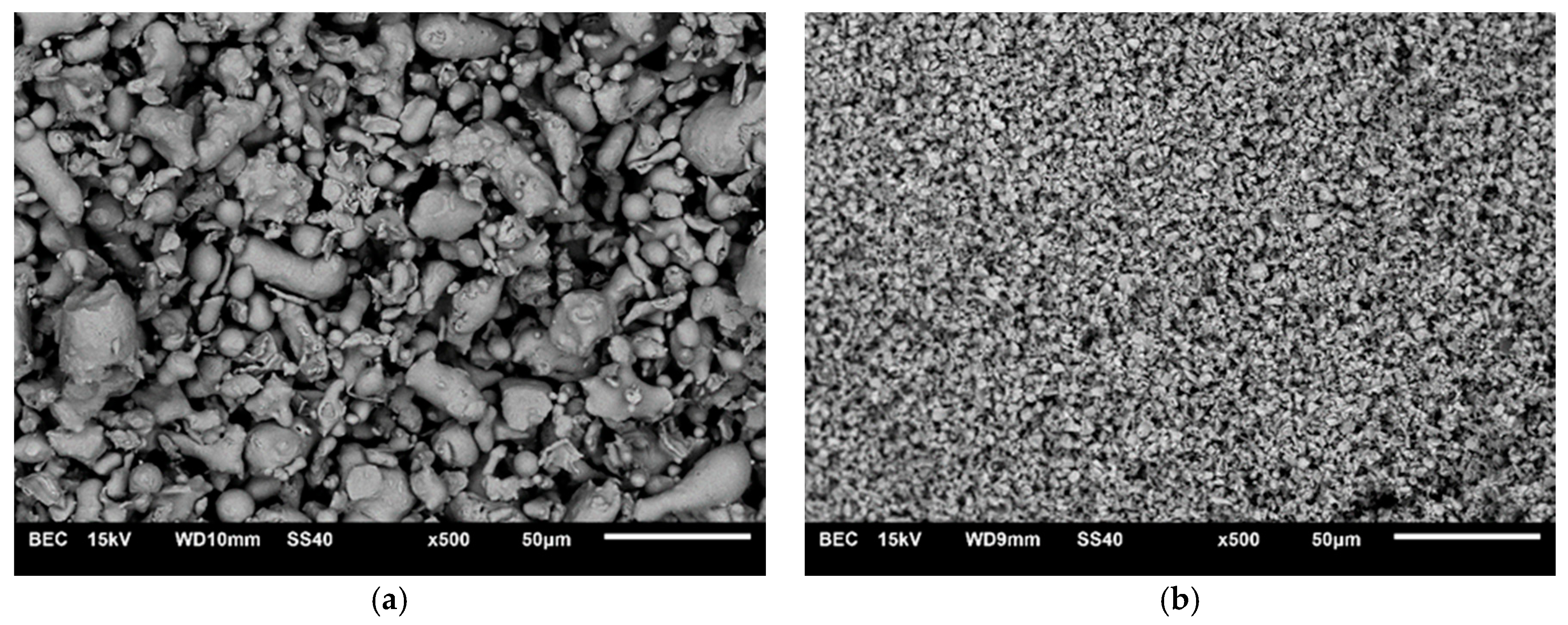
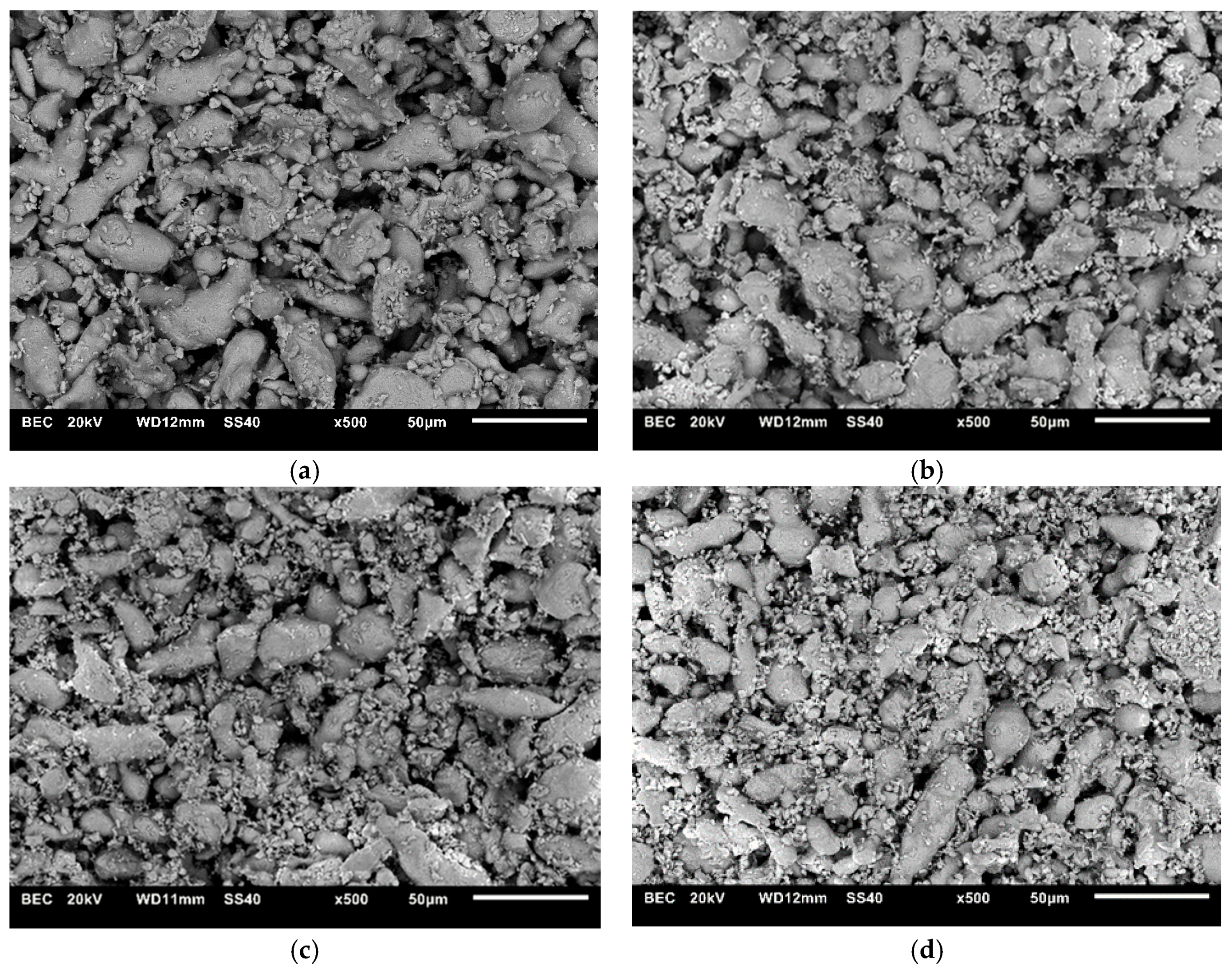

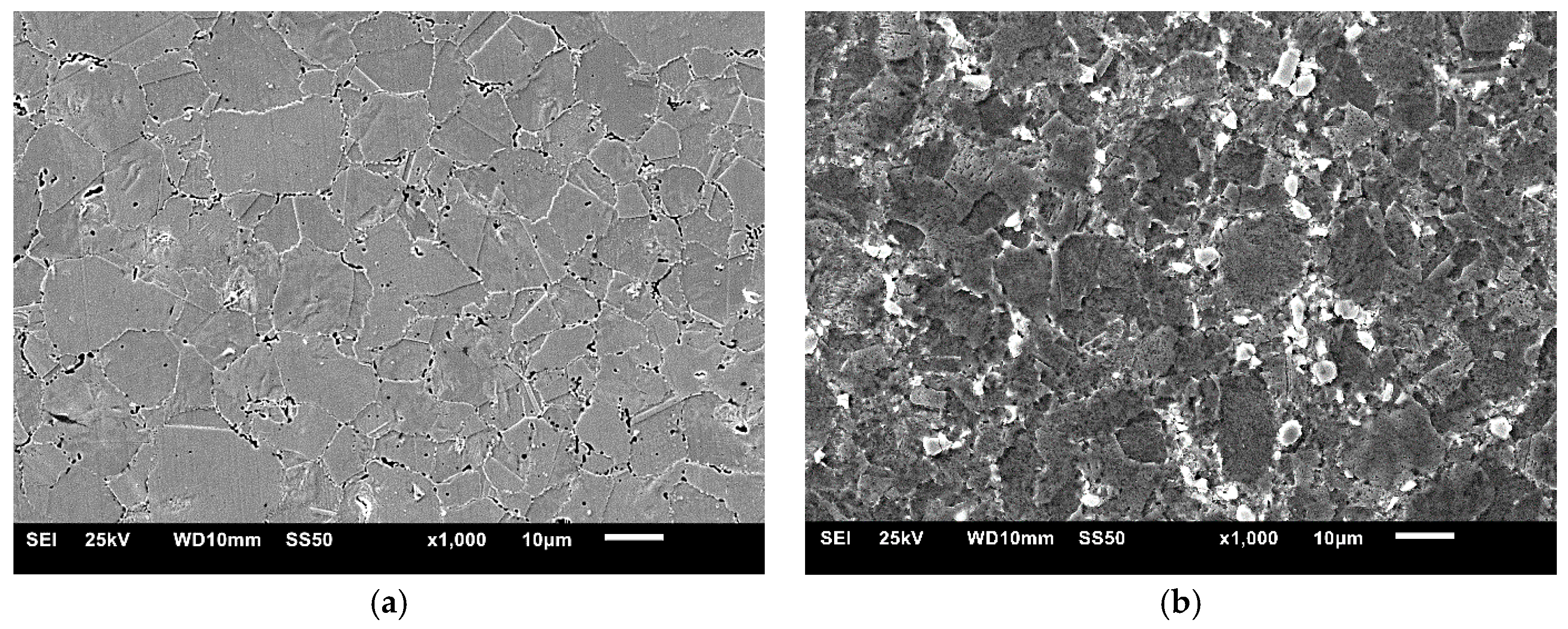
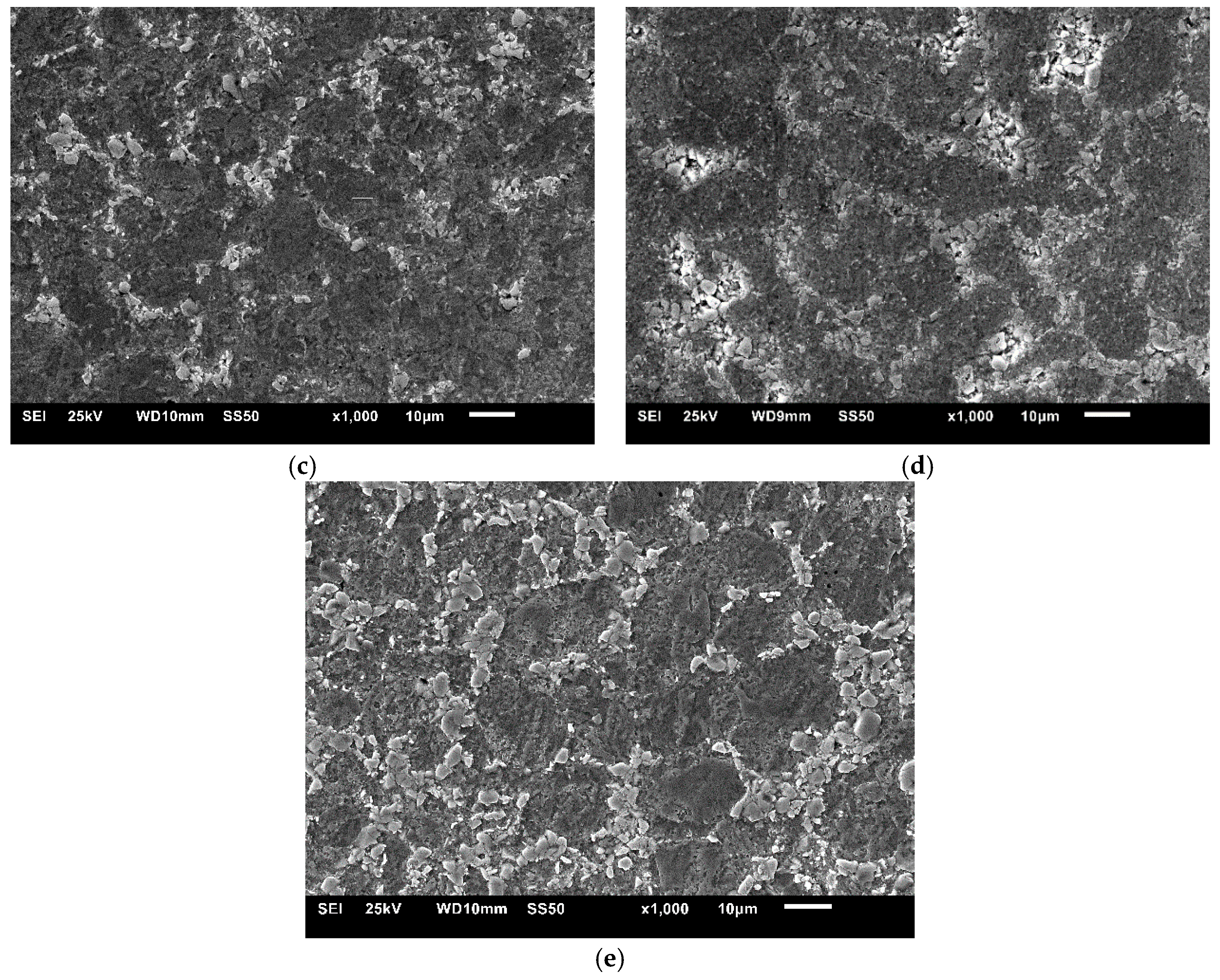





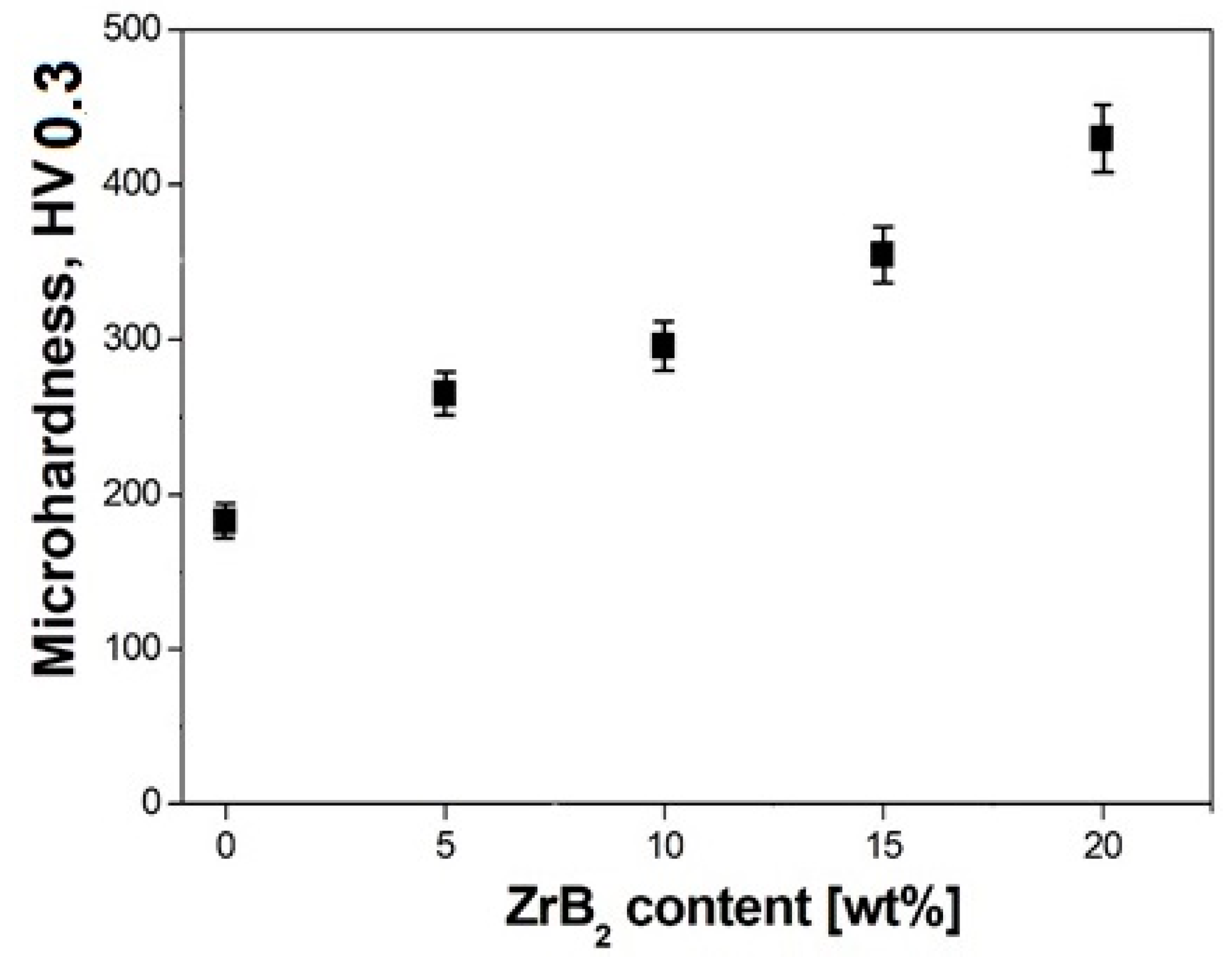
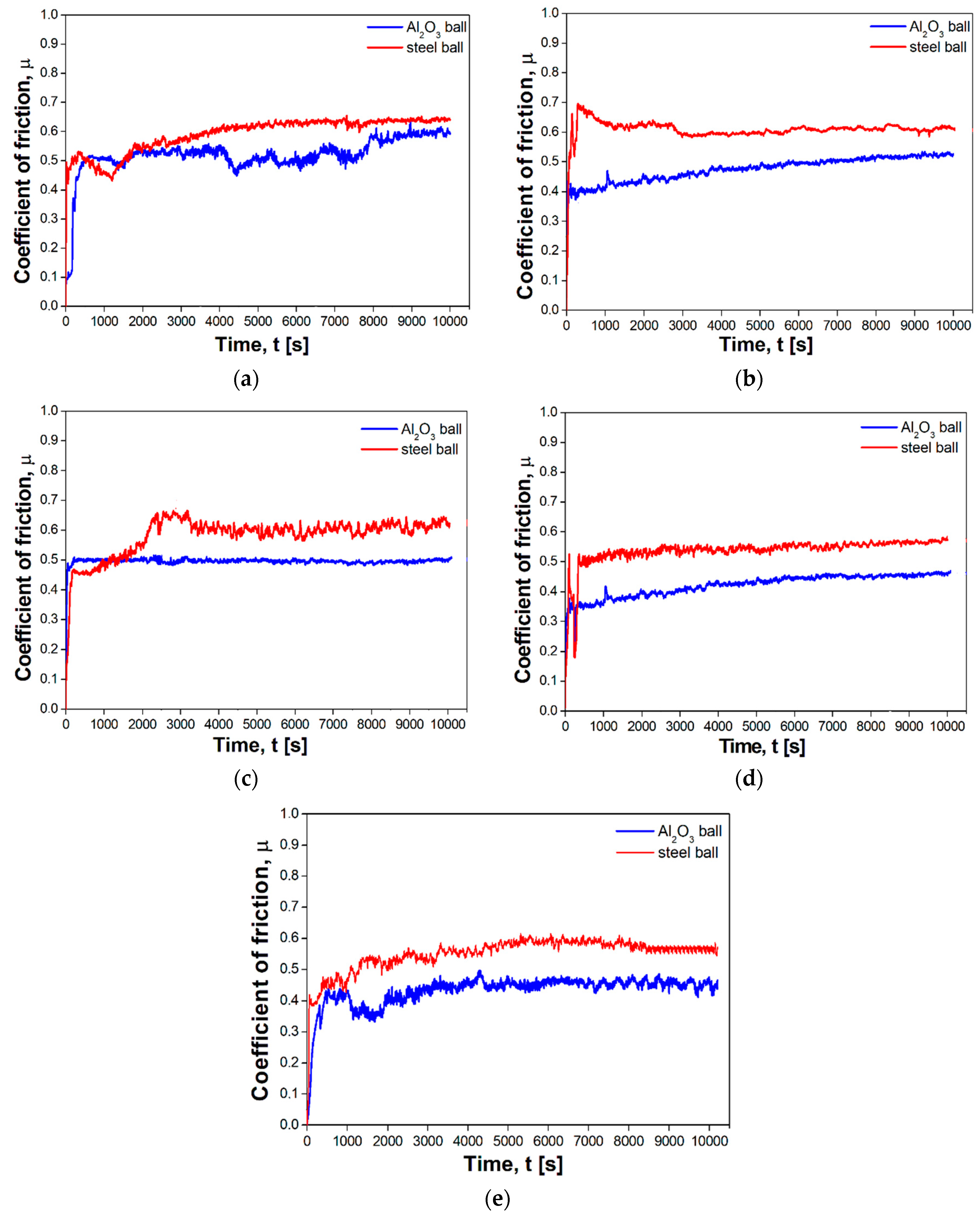
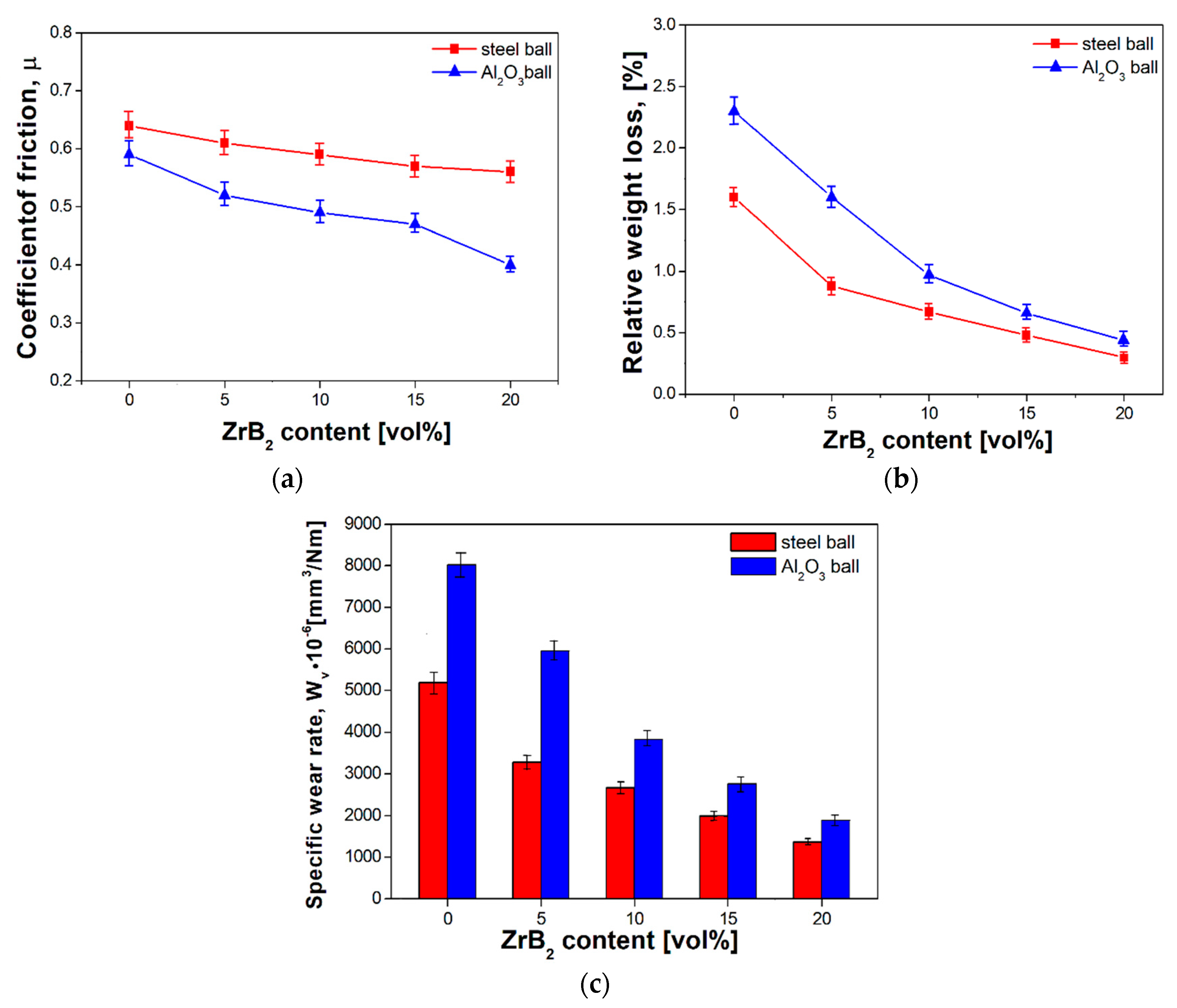
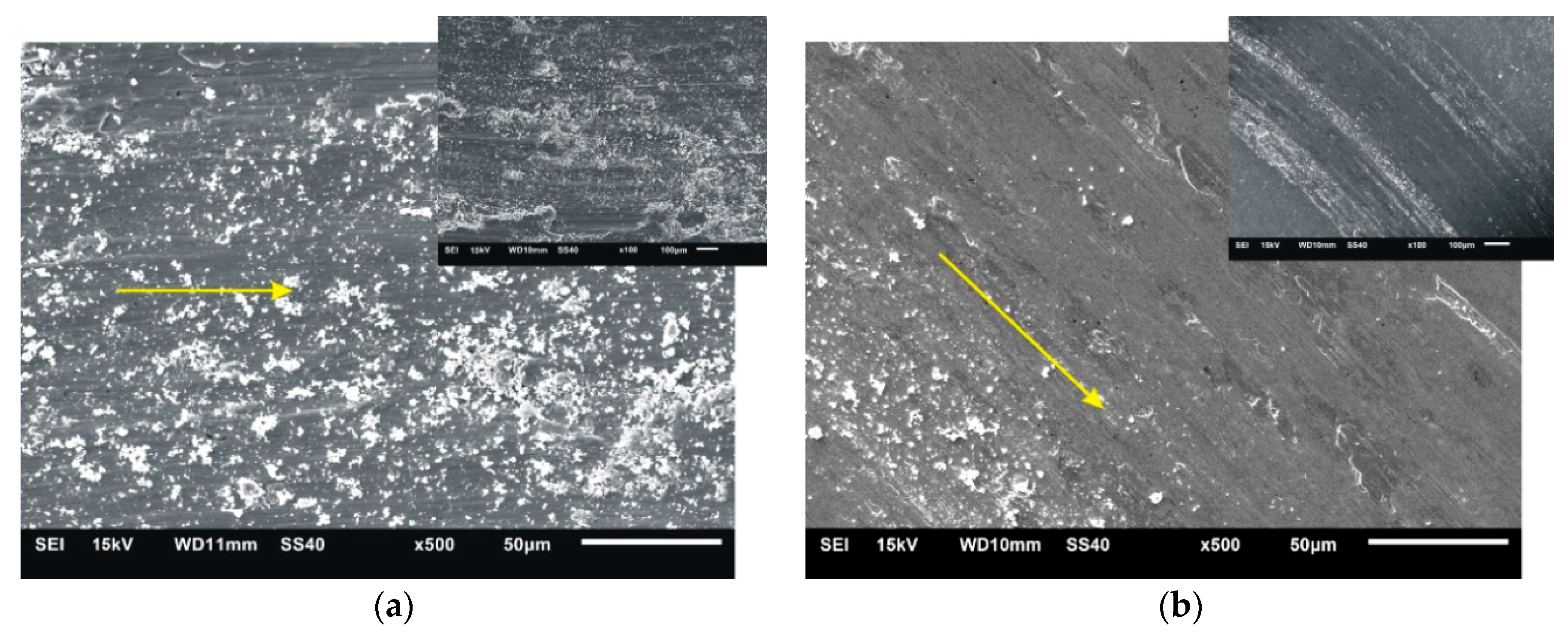
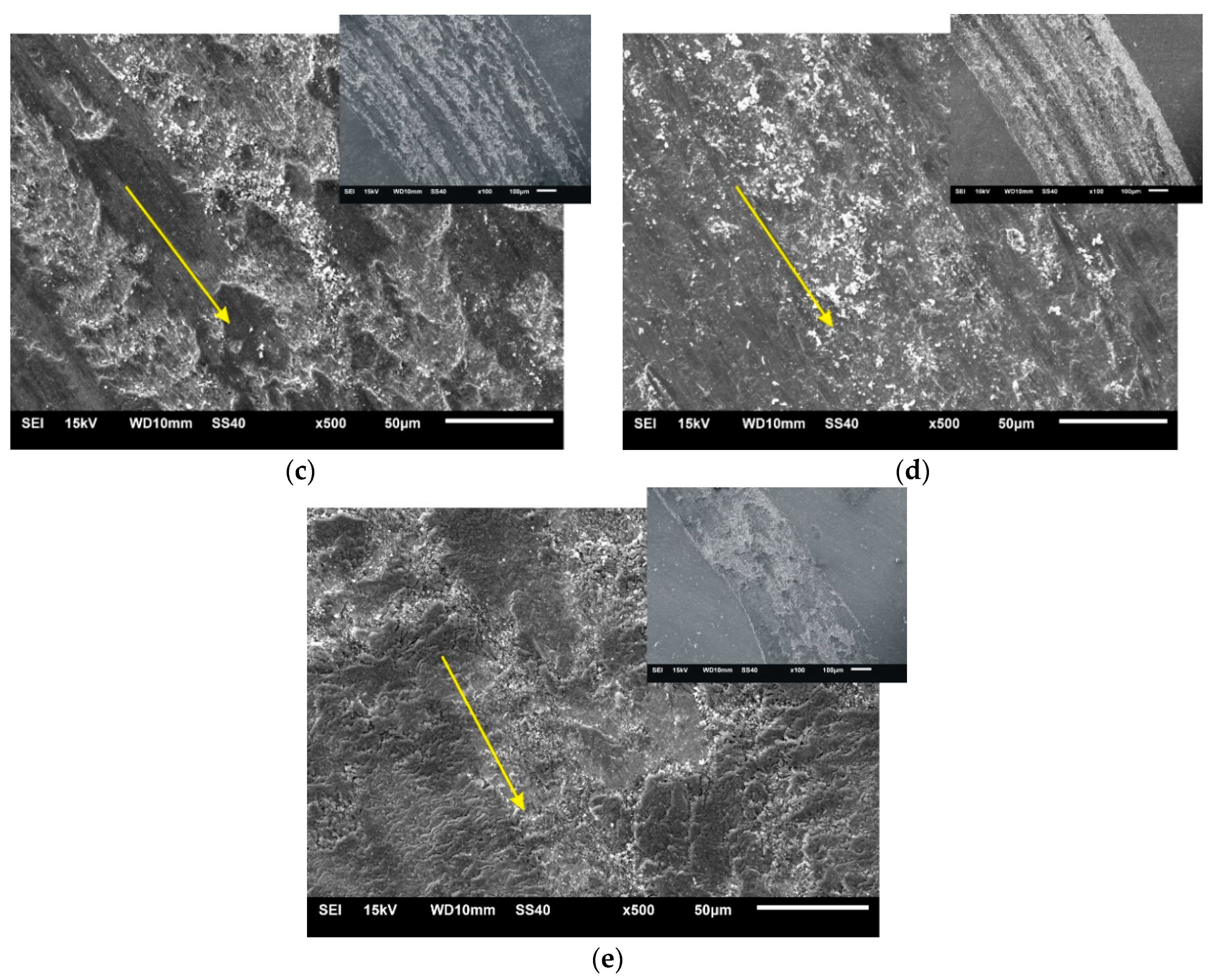
| Sintered Materials | Apparent Density ρ [g/cm3] | [%] | Poisson’s Ratioν | Young’s Modulus E [GPa] | [%] |
|---|---|---|---|---|---|
| 316L steel | 7.79 ± 0.02 | 98 | 0.28 | 204 ± 4 | 91 |
| Steel + 5% ZrB2 | 7.39 ± 0.02 | 94 | 0.28 | 210 ± 4 | 88 |
| steel + 10% ZrB2 | 7.32 ± 0.02 | 94 | 0.27 | 220 ± 4 | 87 |
| steel + 15% ZrB2 | 7.15 ± 0.02 | 93 | 0.26 | 228 ± 5 | 90 |
| steel + 20% ZrB2 | 7.07 ± 0.02 | 93 | 0.27 | 236 ± 5 | 89 |
© 2020 by the authors. Licensee MDPI, Basel, Switzerland. This article is an open access article distributed under the terms and conditions of the Creative Commons Attribution (CC BY) license (http://creativecommons.org/licenses/by/4.0/).
Share and Cite
Sulima, I.; Hyjek, P.; Jaworska, L.; Perek-Nowak, M. Influence of ZrB2 on Microstructure and Properties of Steel Matrix Composites Prepared by Spark Plasma Sintering. Materials 2020, 13, 2459. https://doi.org/10.3390/ma13112459
Sulima I, Hyjek P, Jaworska L, Perek-Nowak M. Influence of ZrB2 on Microstructure and Properties of Steel Matrix Composites Prepared by Spark Plasma Sintering. Materials. 2020; 13(11):2459. https://doi.org/10.3390/ma13112459
Chicago/Turabian StyleSulima, Iwona, Pawel Hyjek, Lucyna Jaworska, and Malgorzata Perek-Nowak. 2020. "Influence of ZrB2 on Microstructure and Properties of Steel Matrix Composites Prepared by Spark Plasma Sintering" Materials 13, no. 11: 2459. https://doi.org/10.3390/ma13112459





